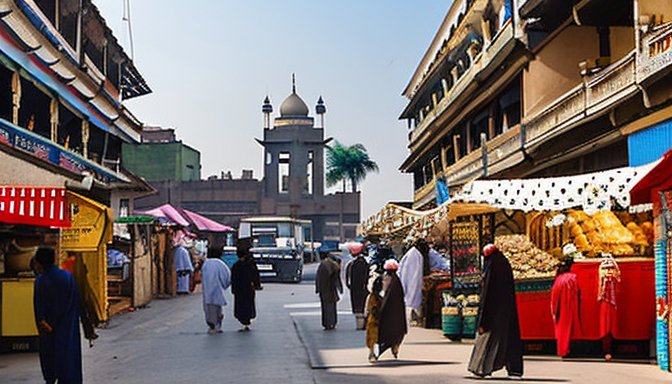Karachi’s colonial past is like a fascinating storybook. Each page tells tales of British influence, from the grand buildings to the policies that shaped the city. Imagine walking through the streets, where every corner reveals a piece of history. The architecture here is not just about bricks and mortar; it’s a blend of styles that reflect the city’s evolution. Think of the stunning Frere Hall or the majestic Mohatta Palace. These structures are more than just pretty facades; they are symbols of a time when Karachi was a bustling hub for trade and culture.
The British established Karachi as a key port, and their policies transformed it into a melting pot of cultures. This urban landscape is a tapestry woven with diverse threads—traditions, languages, and lifestyles. The colonial era introduced new ideas and practices that still echo in the city’s vibrant life today. For instance, the influence of British education can be seen in the schools that dot the city, shaping generations of Karachiites.
But it’s not just about the buildings or policies. It’s about how these elements come together to form Karachi’s unique identity. The colonial legacy is ever-present, influencing everything from food to festivals. So, as you stroll through Karachi, remember: you’re walking through a living museum that tells the story of resilience, adaptation, and a rich cultural exchange.
Architectural Heritage
Karachi’s colonial past is like a fascinating book, filled with stories waiting to be told. The British era left behind a treasure trove of architecture that still stands tall today. Can you imagine walking through streets lined with buildings that whisper secrets of a bygone era? From the grandiose structures to the quaint little corners, each building has its own tale.
Take a moment to think about the majestic Frere Hall. This stunning structure, built in the 1860s, showcases Gothic Revival architecture. Its lush gardens and intricate designs make it a popular spot for both locals and tourists. Then there’s the Empress Market, a bustling hub that reflects the vibrant life of Karachi. Built in 1889, it’s not just a market; it’s a symbol of the city’s cultural melting pot.
The impact of colonial policies on Karachi’s urban landscape is profound. The British designed the city with a vision, introducing wide roads and public parks. These features were not just for aesthetics; they shaped the way people interacted and lived. Today, Karachi’s skyline is a mix of the old and the new, where colonial buildings coexist with modern architecture.
In essence, Karachi’s architectural heritage is more than just bricks and mortar. It’s a living testament to the city’s evolution, a blend of cultures, and a reminder of the complex history that continues to influence its identity. So, next time you stroll through the city, take a moment to appreciate the stories hidden within these walls.

Cultural Influences
The colonial past of Karachi is like a vibrant tapestry, woven from various threads of culture and tradition. The British era left a significant mark on the city’s identity, shaping not just its architecture but also its social fabric. You can see this influence in everyday life, from the way people interact to the festivals they celebrate. It’s fascinating how a city’s history can echo through its streets and in its people.
Take a stroll through the city, and you’ll come across stunning colonial buildings. Each structure tells a story, whispering tales of the past. These buildings are not just old; they are symbols of a time when Karachi was a bustling hub of trade and commerce. The blend of European styles with local designs creates a unique architectural language that is distinctly Karachi.
Moreover, the policies implemented during the colonial era have lasting effects. For instance, the establishment of educational institutions and public spaces transformed how communities interacted. These institutions continue to nurture talent and foster a sense of community. The impact is evident in:
- Education: Schools and universities that were founded during this time still thrive, shaping future generations.
- Cultural Festivals: Events like the Karachi Literature Festival celebrate diverse voices, reflecting the city’s rich heritage.
- Social Dynamics: The mix of cultures has led to a unique blend of traditions, making Karachi a melting pot.
In essence, Karachi’s colonial legacy is more than just buildings. It’s about the stories, the people, and the ongoing evolution of its cultural landscape. This history continues to influence how Karachiites see themselves and their city today.
Frequently Asked Questions
- What is the significance of Karachi’s colonial architecture?
Karachi’s colonial architecture is not just about beautiful buildings; it tells the story of the city’s rich history and evolution. Each structure represents a blend of different styles and influences that reflect the cultural tapestry of the time.
- How has colonialism influenced Karachi’s culture?
The colonial legacy has deeply shaped Karachi’s cultural landscape, integrating diverse traditions and practices. This fusion has created a unique social fabric that continues to influence community interactions and local customs today.
- Are there any notable colonial buildings to visit in Karachi?
Absolutely! Karachi is home to several remarkable colonial buildings, such as the Frere Hall and the Sindh High Court. These sites not only showcase stunning architecture but also offer a glimpse into the city’s historical narrative.
- What impact does colonial history have on Karachi’s identity today?
The impact is profound! Karachi’s identity is a mosaic of its colonial past, where historical influences continue to shape its modern culture, architecture, and even urban development, making it a city of contrasts.